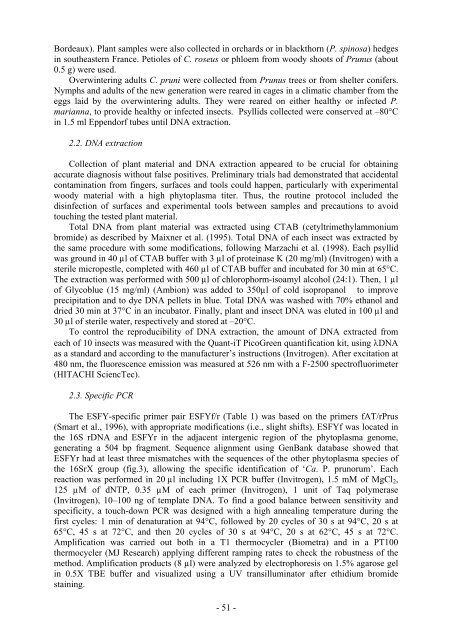Ecole Nationale Supérieure Agronomique de Montpellier ... - CIAM
Ecole Nationale Supérieure Agronomique de Montpellier ... - CIAM
Ecole Nationale Supérieure Agronomique de Montpellier ... - CIAM
Create successful ePaper yourself
Turn your PDF publications into a flip-book with our unique Google optimized e-Paper software.
Bor<strong>de</strong>aux). Plant samples were also collected in orchards or in blackthorn (P. spinosa) hedges<br />
in southeastern France. Petioles of C. roseus or phloem from woody shoots of Prunus (about<br />
0.5 g) were used.<br />
Overwintering adults C. pruni were collected from Prunus trees or from shelter conifers.<br />
Nymphs and adults of the new generation were reared in cages in a climatic chamber from the<br />
eggs laid by the overwintering adults. They were reared on either healthy or infected P.<br />
marianna, to provi<strong>de</strong> healthy or infected insects. Psyllids collected were conserved at –80°C<br />
in 1.5 ml Eppendorf tubes until DNA extraction.<br />
2.2. DNA extraction<br />
Collection of plant material and DNA extraction appeared to be crucial for obtaining<br />
accurate diagnosis without false positives. Preliminary trials had <strong>de</strong>monstrated that acci<strong>de</strong>ntal<br />
contamination from fingers, surfaces and tools could happen, particularly with experimental<br />
woody material with a high phytoplasma titer. Thus, the routine protocol inclu<strong>de</strong>d the<br />
disinfection of surfaces and experimental tools between samples and precautions to avoid<br />
touching the tested plant material.<br />
Total DNA from plant material was extracted using CTAB (cetyltrimethylammonium<br />
bromi<strong>de</strong>) as <strong>de</strong>scribed by Maixner et al. (1995). Total DNA of each insect was extracted by<br />
the same procedure with some modifications, following Marzachi et al. (1998). Each psyllid<br />
was ground in 40 µl of CTAB buffer with 3 µl of proteinase K (20 mg/ml) (Invitrogen) with a<br />
sterile micropestle, completed with 460 µl of CTAB buffer and incubated for 30 min at 65°C.<br />
The extraction was performed with 500 µl of chlorophorm-isoamyl alcohol (24:1). Then, 1 µl<br />
of Glycoblue (15 mg/ml) (Ambion) was ad<strong>de</strong>d to 350µl of cold isopropanol to improve<br />
precipitation and to dye DNA pellets in blue. Total DNA was washed with 70% ethanol and<br />
dried 30 min at 37°C in an incubator. Finally, plant and insect DNA was eluted in 100 µl and<br />
30 µl of sterile water, respectively and stored at –20°C.<br />
To control the reproducibility of DNA extraction, the amount of DNA extracted from<br />
each of 10 insects was measured with the Quant-iT PicoGreen quantification kit, using λDNA<br />
as a standard and according to the manufacturer’s instructions (Invitrogen). After excitation at<br />
480 nm, the fluorescence emission was measured at 526 nm with a F-2500 spectrofluorimeter<br />
(HITACHI SciencTec).<br />
2.3. Specific PCR<br />
The ESFY-specific primer pair ESFYf/r (Table 1) was based on the primers fAT/rPrus<br />
(Smart et al., 1996), with appropriate modifications (i.e., slight shifts). ESFYf was located in<br />
the 16S rDNA and ESFYr in the adjacent intergenic region of the phytoplasma genome,<br />
generating a 504 bp fragment. Sequence alignment using GenBank database showed that<br />
ESFYr had at least three mismatches with the sequences of the other phytoplasma species of<br />
the 16SrX group (fig.3), allowing the specific i<strong>de</strong>ntification of ‘Ca. P. prunorum’. Each<br />
reaction was performed in 20 µl including 1X PCR buffer (Invitrogen), 1.5 mM of MgCl2,<br />
125 µM of dNTP, 0.35 µM of each primer (Invitrogen), 1 unit of Taq polymerase<br />
(Invitrogen), 10–100 ng of template DNA. To find a good balance between sensitivity and<br />
specificity, a touch-down PCR was <strong>de</strong>signed with a high annealing temperature during the<br />
first cycles: 1 min of <strong>de</strong>naturation at 94°C, followed by 20 cycles of 30 s at 94°C, 20 s at<br />
65°C, 45 s at 72°C, and then 20 cycles of 30 s at 94°C, 20 s at 62°C, 45 s at 72°C.<br />
Amplification was carried out both in a T1 thermocycler (Biometra) and in a PT100<br />
thermocycler (MJ Research) applying different ramping rates to check the robustness of the<br />
method. Amplification products (8 µl) were analyzed by electrophoresis on 1.5% agarose gel<br />
in 0.5X TBE buffer and visualized using a UV transilluminator after ethidium bromi<strong>de</strong><br />
staining.<br />
- 51 -



